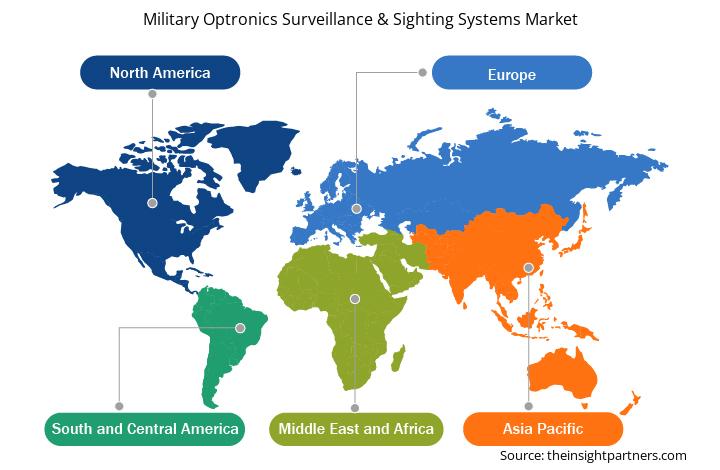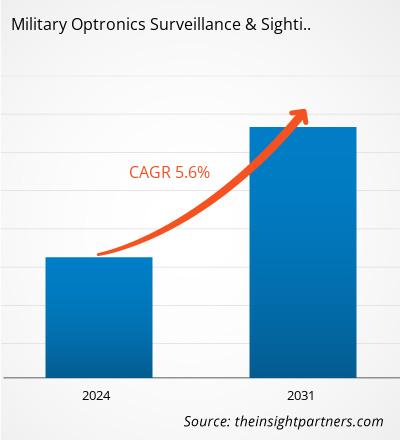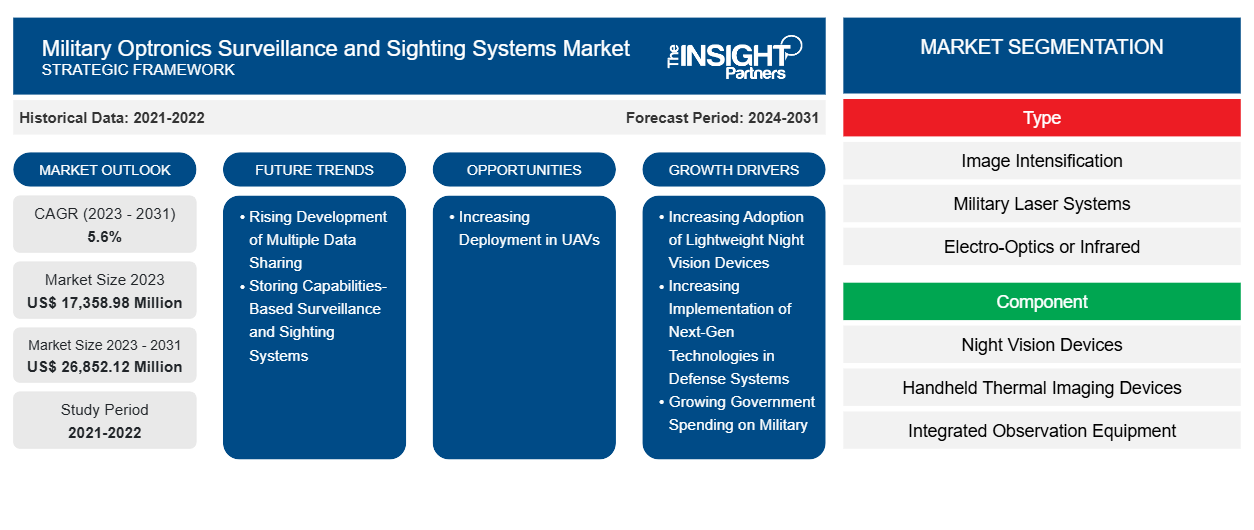军用光电监视和瞄准系统市场规模预计将从 2023 年的 173.5898 亿美元增至 2031 年的 268.5212 亿美元。预计 2023-2031 年期间市场复合年增长率为 5.6%。基于多种数据共享和存储功能的监视和瞄准系统的不断发展可能会在未来几年为市场带来新的关键趋势。
军用光电监视和瞄准系统市场分析
随着创新的不断增加和夜间恐怖袭击威胁的不断增加,夜视设备的采用也在不断增加。同样,热成像可以帮助士兵在能见度较差的条件下找到目标。热成像夜视设备在全球范围内越来越受欢迎,以加强单兵系统。夜视设备通过在夜间行动中照亮周围环境,为士兵提供更强的态势感知能力。政府越来越多地致力于开发和采用基于先进技术的轻型夜视设备,为军用光电监视和瞄准系统市场的增长创造了巨大的需求。例如,2022 年 1 月,美国国防部国防高级研究计划局 (DARPA) 选择了 10 个国防和大学研究团队,为美国军人开发轻型夜视光学设备。该部门设计了眼镜式增强夜视 (ENVision) 计划,以采用新技术开发夜视系统。
为了保护邻国的土地,全球范围内越来越多地部署无人机,预计将在预测期内为光电监视和瞄准系统市场增长创造充足的机会。例如,2022 年,印度陆军部署了首批 25 多架以色列制造的无人机,名为“搜索者 Mark II”。此外,2024 年 5 月,美国政府开始向其军方交付无人机,作为其对抗中国国防能力的政府计划的一部分。此外,2023 年 3 月,中国科学家开发了一种军用无人机,它能够在半空中迅速分成六个独立单元。这些无人机采用空气分离技术制造。预计在预测期内,多个国家政府对无人机的投资和部署将为光电监视和瞄准系统市场创造充足的机会。
军事光电监视和瞄准系统市场概况
军用光电、监视和瞄准系统为人员提供了足够的工具来识别、跟踪、监控和应对空中、陆地和海上战争环境中的威胁。这些系统通过集成高性能光学元件和先进传感器,为武装部队提供精确的目标检测、识别和识别以及态势感知。此外,光电、监视和瞄准系统还可用于满足边境控制、基地保护、侦察和情报收集任务要求。光电和监视系统的技术进步,加上国防部队对升级现有设备和系统的持续需求,正在推动全球军用光电、监视和瞄准系统市场的发展。
定制此报告以满足您的需求
您可以免费定制任何报告,包括本报告的部分内容、国家级分析、Excel 数据包,以及为初创企业和大学提供优惠和折扣
-
获取此报告的关键市场趋势。这个免费样品将包括数据分析,从市场趋势到估计和预测。
军用光电监视和瞄准系统市场驱动因素和机遇
轻型夜视设备的采用率不断提高
随着创新的不断增加和夜间恐怖袭击威胁的不断上升,夜视设备的采用率正在上升。以前,夜视设备使用相对较重的组件,增加了士兵的重量。现在,各种市场参与者都在推出轻量级夜视产品。例如,ACTinBlack 开发了一种轻型双目夜视设备,具有高光学性能和符合人体工程学的设计。2023 年 10 月,美国热成像和增强现实 (AR) 公司 Thermoteknix Systems 推出了一种名为融合夜视镜和高级增强现实 (FNVG-AR) 的夜视解决方案。FNVG-AR 系统是一款轻型双目夜视镜 (NVG),集成了基于先进技术的下一代 16 毫米白色荧光夜视管和高分辨率热像仪。
增加无人机部署
无人系统已成为全球军事力量不可或缺的一部分,因为它们可以降低对人类生命的威胁。由于无人机 (UAV) 具有多种优势,许多国家(例如美国、印度和中国)已拨出大量预算在其军事力量中部署更多无人机,主要用于监视应用。在无人平台上部署光电监视和瞄准系统有助于传输监视和图像数据。无人系统与通信天线和其他监视设备的集成有助于完成各种关键任务。因此,无人机越来越多地用于空中和海军监视和测绘任务,导致对光电监视和瞄准系统的需求日益增长,这些系统可以有效地集成到无人机平台中而不会影响其整体效率。因此,军用光电监视和瞄准系统市场中的几家主要行业参与者(包括拉斐尔先进防御系统有限公司和洛克希德马丁)强调开发和提供用于无人机平台的光电监视和瞄准系统。
军用光电监视和瞄准系统市场报告细分分析
促成军事光电监视和瞄准系统市场分析的关键部分是类型、组件和最终用户。
- 根据类型,军用光电监视和瞄准系统市场分为图像增强、军用激光系统和电光/红外。2023 年,电光部分占据了最大的市场份额。
- 根据组件,市场分为夜视设备、手持式热成像设备、综合观察设备、独立红外、地震和声学传感器等。地震和声学传感器领域在 2023 年占据了市场主导地位。
- 就最终用户而言,军用光电监视和瞄准系统市场分为地面、机载和海军。地面部分在 2023 年占据了最大的市场份额。
军用光电监视和瞄准系统市场份额分析
军事光电监视和瞄准系统市场报告的地理范围提供了详细的全球分析。北美、欧洲和亚太地区是军事光电监视和瞄准系统市场显着增长的主要地区。北美的军事光电监视和瞄准系统市场进一步细分为美国、加拿大和墨西哥。2023 年,美国在北美军事光电监视和瞄准系统市场占据主导地位,2023 年占有相当大的市场份额,其次是加拿大和墨西哥。这些发达经济体将其 GDP 的相当一部分用于军费开支。根据世界银行收集的从官方认可来源汇编的发展指标,据报道,2023 年美国的军费开支约占其 GDP 的 3.5%。此外,根据美国联邦预算部的数据,在 2023 财年,美国政府在国防领域花费了 8200 亿美元。该金额估计占美国联邦支出的 13%。市场的主要参与者正在开发基于机载光电监视系统、先进数字热成像摄像机、跟踪和搜索系统等的先进技术。例如,总部位于美国的 Obsidian Sensors Inc. 于 2023 年推出了一项新技术,该技术使用价格实惠的高分辨率传感器处理热成像。
军事光电监视和瞄准系统市场区域洞察
Insight Partners 的分析师已详尽解释了预测期内影响军事光电监视和瞄准系统市场的区域趋势和因素。本节还讨论了军事光电监视和瞄准系统市场的各个部分以及北美、欧洲、亚太地区、中东和非洲以及南美和中美洲的地理位置。

- 获取军事光电监视和瞄准系统市场的区域特定数据
军用光电监视和瞄准系统市场报告范围
| 报告属性 | 细节 |
|---|---|
| 2023 年的市场规模 | 173.5898亿美元 |
| 2031 年市场规模 | 268.5212亿美元 |
| 全球复合年增长率(2023 - 2031) | 5.6% |
| 史料 | 2021-2022 |
| 预测期 | 2024-2031 |
| 涵盖的领域 |
按类型
|
| 覆盖地区和国家 |
北美
|
| 市场领导者和主要公司简介 |
|
军用光电监视和瞄准系统市场参与者密度:了解其对业务动态的影响
军事光电监视和瞄准系统市场正在快速增长,这得益于最终用户需求的不断增长,这些需求源于消费者偏好的不断变化、技术进步以及对产品优势的认识不断提高等因素。随着需求的增加,企业正在扩大其产品范围,进行创新以满足消费者需求,并利用新兴趋势,从而进一步推动市场增长。
市场参与者密度是指在特定市场或行业内运营的企业或公司的分布情况。它表明在给定市场空间中,相对于其规模或总市场价值,有多少竞争对手(市场参与者)存在。
在军事光电监视和瞄准系统市场运营的主要公司有:
- 空客
- 洛克希德·马丁公司
- 泰雷兹集团
- 通用动力公司
- L3Harris 技术公司
- 以色列航空工业公司
免责声明:上面列出的公司没有按照任何特定顺序排列。

- 了解军事光电监视和瞄准系统市场顶级关键参与者概况
军用光电监视和瞄准系统市场新闻和最新发展
军事光电监视和瞄准系统市场通过收集一手和二手研究后的定性和定量数据进行评估,其中包括重要的公司出版物、协会数据和数据库。军事光电监视和瞄准系统市场的一些发展如下所列:
- 传感器专家 HENSOLDT 为 PUMA 步兵战车提供数量不详的先进光学视觉系统。客户是系统公司 KNDS 和莱茵金属,它们生产 PUMA 步兵战车并通过联合成立的 PSM GmbH 进行分销。订单价值在数千万左右。除了步兵战车炮塔的视觉系统外,订单还包括用于训练车辆乘员的十二个炮塔训练器的设备。通过此次交付,HENSOLDT 正在帮助改进 K-Stand S1 上的 PUMA。(来源:HENSOLDT,新闻稿,2024 年 6 月)
- 法国军队已收到法国国防采购局 (DGA) 于 2020 年订购的首批 300 副泰雷兹夜视镜,这是 Bi-NYX 合同的一部分。交付给 DGA 的 300 副夜视镜是 2023 年 12 月下达的 2,000 副订单的首批。其余 1,700 副将于今年年底发货。(来源:泰雷兹,新闻稿,2024 年 10 月)
军用光电监视和瞄准系统市场报告覆盖范围和交付成果
《军用光电监视和瞄准系统市场规模和预测(2021-2031 年)》报告对市场进行了详细分析,涵盖:
- 军事光电监视和瞄准系统市场规模以及范围内所有主要细分市场在国家层面的预测
- 军用光电监视和瞄准系统市场趋势,以及驱动因素、限制因素和关键机遇等市场动态
- 详细的 PEST 和 SWOT 分析
- 军事光电监视和瞄准系统市场分析,涵盖主要市场趋势、国家框架、主要参与者、法规和最新市场发展
- 行业格局和竞争分析,涵盖市场集中度、热图分析、知名参与者以及军用光电监视和瞄准系统市场的最新发展
- 详细的公司简介
- 历史分析(2 年)、基准年、预测(7 年)及复合年增长率
- PEST和SWOT分析
- 市场规模、价值/数量 - 全球、区域、国家
- 行业和竞争格局
- Excel 数据集
近期报告
相关报告
客户评价
购买理由
- 明智的决策
- 了解市场动态
- 竞争分析
- 客户洞察
- 市场预测
- 风险规避
- 战略规划
- 投资论证
- 识别新兴市场
- 优化营销策略
- 提升运营效率
- 顺应监管趋势























 获取免费样品 - 军事光电监视和瞄准系统市场
获取免费样品 - 军事光电监视和瞄准系统市场